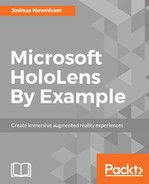One of the most significant advancements of HoloLens has little to do with the actual technology and more to do with where it is placed. Having a computer situated conveniently on your head lends itself to many interesting avenues. It means having a computer easily accessible any place and in any situation and, equally important, having a computer that is capable of seeing what you see and hearing what you hear. Smartphones have taken us to a paradigm where we have had always-on and always-connected computers, but this extends this concept even further, whereby our devices can be more aware of our situation, but of course this is only possible if the applications we build for these platforms take advantage of these opportunities. In this chapter, we start exploring this concept by way of example, whereby we will use Microsoft's Cognitive Services (Microsoft's Cognitive Services), to recognize people in the user's view and, if recognized, display associated metadata--name in this case. While reading through this chapter, I encourage you to let your mind drift and imagine how else augmentation can be applied to enhance people's lives.
While working through this chapter (and example), we will touch on the following topics:
- A brief walkthrough of the Visual C# Holographic DirectX 11 App template provided by Microsoft
- Capturing frames from the HoloLens color camera
- Using Microsoft's Cognitive Services to detect and identify faces
- Positioning a name tag relative to a recognized face in the users view
